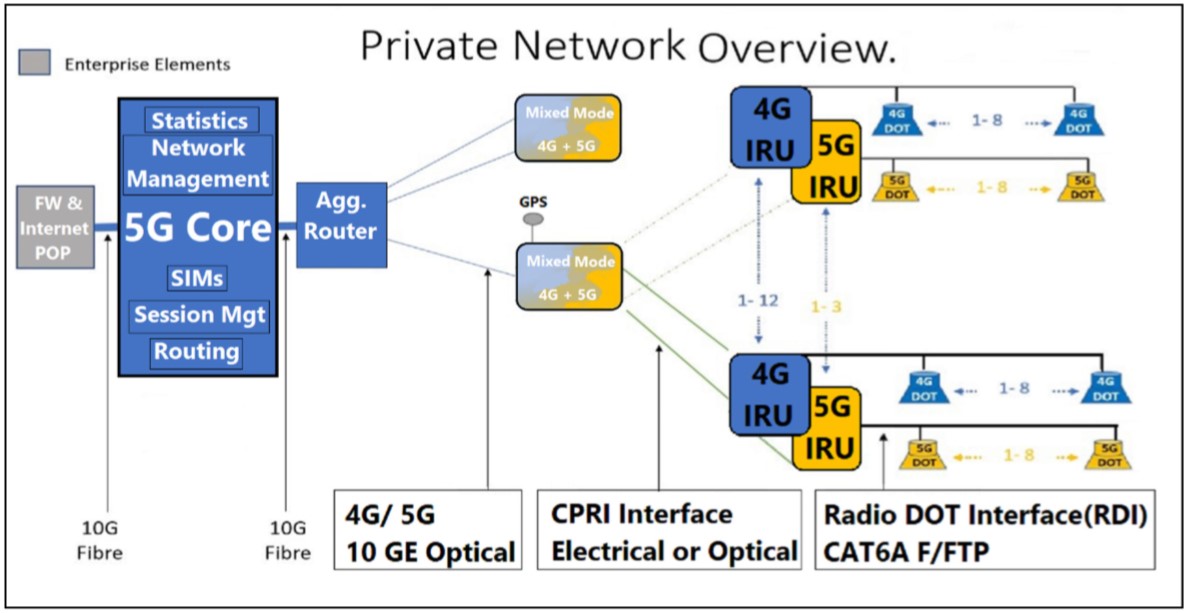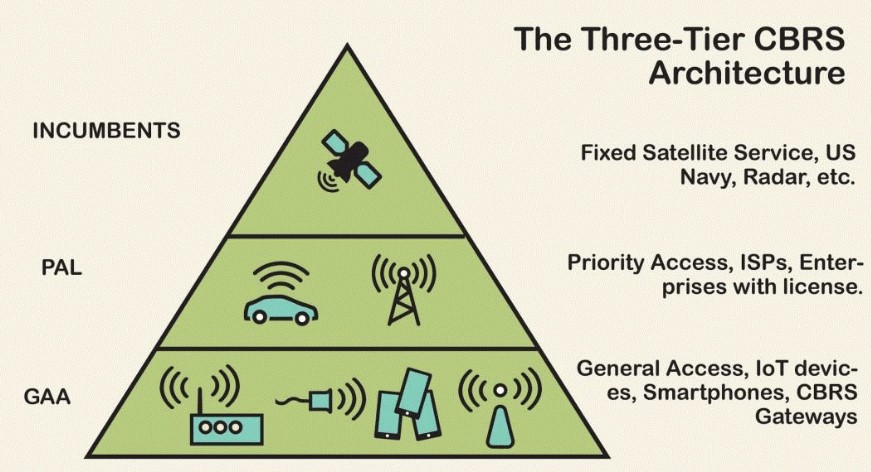5G PRIVATE NETWORKS
5G Private Networks Overview:
A dedicated fifth-generation (5G) network having improved data communication features, defined connectivity, optimized services, and specialized security is called a private 5G network. Incorporating the benefits for both public and private 5G networks, private 5G networks have found use in various industries, the public sector, utilities, and businesses. The idea of a private 5G network is one of the encouraging Industry 4.0 accelerators.
Worldwide rollouts of fifth generation (5G) cellular networks have begun. Through multi-Giga bits per seconds peak rates with extremely less latency and great dependability, 5G networks are transforming both the professional world and our day to day life. However, there are also significant obstacles to widespread adoption for public 5G networks, which mobile network operators handle. Among them is coverage. In order to generate enough money to pay for network development costs, mobile network operators frequently place their networks in regions with high subscriber densities. This could lead to a lack of network coverage in more remote places and weak network coverage in less populous metropolitan sites. In interior areas with challenging radio frequency (RF) circumstances, coverage may also be subpar. In addition, high-tech industrial enterprises need to employ tailored rules and locally gathered data in a world where data breaches and cyber assaults are commonplace, which are not supported by some of the more established public cellular networks. Due to these drawbacks, private networks also known as non-public networks in the 3rd-Generation-Partnership-Project (3GPP) have garnered a lot of attention.
A private 5G network is a LAN i.e., local area network providing a dedicated wireless access inside certain area that is built using 5G technology. More crucially, it may be autonomously controlled by its owner, giving them complete control over all aspects of the network, including resource allocation, priority scheduling, security, etc. Enterprise users may participate in establishing their own security policies and safeguarding confidential and proprietary information locally. In contrast to Ethernet, a private 5G network eliminates expensive and huge wired infrastructure, allowing for the connection of many devices at once dynamic environment with moving items and people. Private 5G networks provide benefits over private LTE networks in both the radio domain and architecture of the system. Figure 1.1 shows stand Alone deployment of 5G private networks.

Figure 1.1 Stand Alone Deployment of 5G networks
5G networks that are private provide flexibility in spectrum, multi-Giga Bits per seconds peak data throughput, really low latency, ultra-high dependability, and connection in the radio domain.
Figure 1.2 serves as an illustration of a possible deployment layout for 4G/5G in a business network.

Figure 1.2 Private 5G infrastructure supporting Industry
5G Private Network Benefits:
The major three benefits of private networks are availability, reliability and security. Private 5G networks transform companies become mobile providers in a select number of locations. If a corporation wishes to have total control over its operational procedures, it would likely transition from managing a mobile private 5G network (MPN) to operating a 5G network infrastructure. As a consequence, adjustments may be made to aspects like bandwidth or real-time characteristics, which are not available when utilizing a mobile radio provider’s network.
Private 5G networks, compared to public networks, can be set up to meet the unique requirements of a place, and configurations can differ from site to site based on the sort of work being done in each area. Businesses may choose the network’s rollout schedule and coverage level with a private network. Another thing to keep in mind is that onsite staff may be able to build and maintain the network, which would allow for quicker problem resolution, less downtime, and a degree of uptime that satisfies the organization’s requirements.
To establish a genuinely isolated private 5G network, better security, private edge computing, and vertical network slicing are necessary at the system level. Additionally, it must be highlighted that a private 5G network incorporates several benefits from the public 5G networks and, more crucially, makes variety of difficulties easier, including interference control. Repurposing 5G technology, private 5G networks have the following characteristics:
1- Constant availability: A communication service’s availability is analyzed by dividing the end-to-end communication service’s percentage of time spent delivering it in accordance with a predetermined the quality of service (QoS) by the system’s anticipated E2E service delivery time; the requirements in a particular location. The critical values in private 5G networks range from 99.999999 percent to smaller ones, depending on the application scenarios, like 99.9%.
2-Ultra-high dependability: The capability of the communication service to function as needed for a specific amount of time and specific circumstances is referred to as reliability. Wireless IoT and IIoT systems, in particular for industrial automation, require ultra-high level dependability to properly complete essential activities under similar constraints as those in wired systems.
3-Ultra low latency: The ability of a communication network to support mission-crucial applications requiring less than millisecond level E2E latency in their packet transfers is referred to as ultra-low latency. This is crucial for industrial automation because it creates new opportunities for secure interactions between people and robots, such those between workers and automated vehicles in a plant. Each stage of the downlink and uplink transmission operations in 5G are being revised to reduce latency in order to meet this criterion. In this regard, 5G New Radio (NR) uses improved scheduling algorithms, edge computing, fewer permitted retransmissions, and new numerology.
4-Huge device density and high throughput: To support more heterogeneous stationary and mobile devices, such as sensors, programmable logic controllers, actuators, mobile robots, cameras, and devices related to augmented reality (AR) and virtual reality (VR) in private 5G networks. For instance, huge connection is needed to ensure the effective transmission of messages within a specified amount of time. High speed and high accuracy machine jobs, uninterrupted smooth multimedia services, and effective mobile device cooperation will require massive connections supporting multi-Giga bits per seconds peak data rates.
5- In Comparison with 5G networks the Private 5G networks includes features that are unique i.e., high security, customized Quality of Services (QoS) and consistent Machine Learning (ML) models.
How to build your 5G private Networks?
There are six practical steps for implementing 5G private networks shown in the figure below.

Following figure shows simplified private 5G networks design. Small cell hardware such as eNodeB devices and remote radio heads and their associated cabling form the access edge of the network. These devices need strong upstream connectivity to the LAN. Clients access the network as 5G radio devices. Ultimately, through each organizations respective requirements will dictate the network design.
The network design will ultimately be determined by the requirements of each enterprise.
The use of private 5-G networks is increasing globally as authorities provide businesses additional spectrum so they may create and operate their own private 5G networks, which are networks that don’t exchange data with nearby cellular networks. This is a major nut-cracker for businesses, the manufacturers that need 5G communication capabilities to adopt the revolutionary applications that power the internet of things(IoT), smart factories, and digital transformation such as Internet of Things(IoT).
For businesses to build their own private 5G networks, spectrum must be purchased from the government, mobile network operators (MNOs), or other spectrum suppliers. Additionally, they need to purchase base stations, mini-towers, and tiny cells from vendors of network infrastructure and link this equipment to edge devices (smartphones, embedded modules, routers, gateways, etc).
But 5G’s sophistication also brings with it difficulties: The first need is that the devices function on the private network’s wireless spectrum. Second, there is a requirement for thorough integration of 5G hardware, software, and applications. This will highlight the function of collaborators and system integrators. To make it simpler to construct a specialized private 5G network, enterprises should search for those with extensive expertise in 5G networks and technology. However, they should be cautious of vendor lock-in. Regulations must be followed, and there are problems with spectrum availability.

Figure-Private 5G Network Architecture
Private 5G versus Private 4G LTE:
There are three main ranges in which the 5G spectrum is allocated i.e., Low band range is under 1GHz; mid band ranges between 3.3 and 3.8 GHz, 6GHz, and CBRS; and high band ranges over 6GHz and the high band (mm Wave) frequency spans between 26 GHz, 28 GHz, and 40 GHz.
However, because spectrum is a limited resource, wireless operators throughout the world will probably have to combine low-band(<1GHz), mid-band (1-6 GHz), and high-band (24-40GHz) spectrum to provide the kind of 5G experience that their consumers want. Low-band spectrum will enable operators to offer extensive coverage in the 5G era, but it also implies that the speed and latency of the 5G network will most likely only be somewhat faster than what is offered by 4G networks. Your closeness to the cell site will have a significant impact on the performance of the 5G network. Mid-band spectrum, which is in the 1 GHz to 6 GHz range, is thought to be perfect for 5G since it can transmit large amounts of data over long distances. The GSMA cites spectrum in the 3.3 to 3.8 GHz range as being very desirable. The millimeter wave spectrum is the third frequency band that wireless providers are using to roll out 5G. On the spectrum map, this is especially prominent in the 24 GHz range and above. The GSMA advises operators to provide millimeter wave spectrum for mobile services in the 26 GHz, 40 GHz, 50 GHz, and 66 GHz bands. However, the organization also points out that operators are currently utilizing spectrum in the 26 GHz and 28 GHz bands, and that since these channels are contiguous, it is simpler for phones to handle them. Private LTE and CBRS: The U.S. now offers Citizens Broadband Radio Service (CBRS), a new Private LTE network alternative. It uses 150 MHz of the 3.5 GHz C-shared band's spectrum, commonly known as Band 48. (B48). Historically, the U.S. military and fixed satellite services had exclusive usage of this spectrum. However, the FCC has permitted expanded usage of this spectrum, creating possibilities for a variety of new uses. According to industry watchers, CBRS will give enterprises that have never had such a promising and inexpensive choice before access to tremendous wireless networking capabilities. CBRS spectrum is shared and actively managed among three groups:
- Tier 1. Incumbent users, primarily the U.S. Navy and satellite ground stations
- Tier 2. Users with priority access licenses (PALs)
- Tier 3. General authorized users (GAA)
To provide the necessary coverage, CBRS devices may be placed similarly to how conventional Wi-Fi access points are (you may ultimately utilize devices that support both Wi-Fi and CBRS). The SAS, a central database, will be the place where the CBRS system must register. The SAS will pinpoint the new CBRS system’s position, power levels, and any neighboring CBRS systems and other systems using the same spectrum. The system is ready to use once all the data has been analyzed and any potential interference has been eliminated.
Additionally, CBRS offers a three-tiered access system for current users (such as the military and satellite ground stations), as well as General Authorized Access (GAA) for all other users and Priority Access License (PAL) obtained through spectrum auctions. The basics:
- Operates in the 3.5GHz band (3550MHz to 3700MHz)
- Standard LTE (Long-Term Evolution) radio interface
- Supports voice, text and data communication
- In-building, unlicensed ‘small cell’ service
- Requires a Spectrum Allocation Service (SAS) to avoid interference

Figure -CBRS three tires
Figure below shows the main differences.

Figure-Key differences between LTE and 5G Networks
The FCC requirements are adhered to by the design of these access points. Unlike a Wi-Fi network, CBRS devices require authorization before they can start transmitting.
The Spectrum Access System (SAS), which employs sensors to enforce FCC regulations, prevent interference, and manage spectrum allotment, is in charge of authorizing. Before transmitting, CBSDs are intended to “check-in” with the SAS. This element is essential for CBSDs to function since the SAS cannot actively contact devices.
CBSDs use the 3550 to 3700 MHz band to do this. If allowed, the SAS can then catalogue the device and give it permission to communicate.
The LTE RAN and eNodeB operate on specialized hardware, and in an LTE network plan, they are commonly close to one another, either at the base or close to the cell pinnacle. However, the solid EPC is typically integrated and separated from the eNodeB. With this layout, high-velocity, low-inactivity start to finish communication is essentially impossible. By dividing the solid EPC and developing each feature so it could run independently of the others on standard, off-the-shelf server equipment, framework providers like Nokia and Ericsson and guidelines organizations like 3GPP worked to create the 5G New Radio (5G-NR) centre. In light of this, 5G hubs may end up being more dispersed and adaptable in the 5G core. For instance, the combination of 5G core operations and apps at an edge datacenter may now decrease communication routes and improve speed and latency overall. The architectures of the 4G LTE and 5G private networks are shown in the figures below.

Figure -Various 5G network Architectures
Through network slicing, networks may now be tailored thanks to the smaller, more customized 5G core components operating on standard hardware. In the 5G network infrastructure, network slicing enables the operation of several logical “slices” of functionality, each tailored for a particular use-case. A 5G network provider may provide three different slices: one for low latency applications, one for high bandwidth applications, and one for a large number of IoT devices. Some of the 5G core capabilities might not be available at all depending on this optimization. For instance, you wouldn’t want the speech capabilities required for mobile phones if you were simply maintaining IoT devices. Additionally, the available computer power is utilized more effectively because not every slice needs to have precisely the same capabilities.
Related Product
G500ODU is the 5G outdoor router with 5G SA mode, which can only work on n77 and n78 frequencies by band locking.




